NRP1
-
Official Full Name
neuropilin 1
-
Overview
This gene encodes one of two neuropilins, which contain specific protein domains which allow them to participate in several different types of signaling pathways that control cell migration. Neuropilins contain a large N-terminal extracellular domain, made up of complement-binding, coagulation factor V/VIII, and meprin domains. These proteins also contains a short membrane-spanning domain and a small cytoplasmic domain. Neuropilins bind many ligands and various types of co-receptors; they affect cell survival, migration, and attraction. Some of the ligands and co-receptors bound by neuropilins are vascular endothelial growth factor (VEGF) and semaphorin family members. Several alternatively spliced transcript variants that encode different protein isoforms have been described for this gene. [provided by RefSeq, Oct 2011] -
Synonyms
NRP1; neuropilin 1; NP1; NRP; BDCA4; CD304; VEGF165R; neuropilin-1; transmembrane receptor; vascular endothelial cell growth factor 165 receptor;
- Recombinant Proteins
- Cell & Tissue Lysates
- Protein Pre-coupled Magnetic Beads
- Chicken
- Cynomolgus
- Cynomolgus Monkey
- Human
- Mouse
- Rat
- Rhesus Macaque
- E.coli
- HEK293
- HEK293F
- HEK293T
- Human Cell
- Mammalian Cell
- Mammalian cells
- C
- Fc
- hFc
- His
- Avi
- mFc
- Fc|His
- His (Fc)
- His|GST
- His|MBP
- human|IgG1|Fc
- Mouse|IgG2a|Fc
- Myc
- DDK
- N/A
- N
- Background
- Quality Guarantee
- Case Study
- Involved Pathway
- Protein Function
- Interacting Protein
- NRP1 Related Articles
What is NRP1 protein?
NRP1 (neuropilin 1) gene is a protein coding gene which situated on the short arm of chromosome 10 at locus 10p11. This gene encodes one of two neuropilins, which contain specific protein domains which allow them to participate in several different types of signaling pathways that control cell migration. Neuropilins contain a large N-terminal extracellular domain, made up of complement-binding, coagulation factor V/VIII, and meprin domains. These proteins also contains a short membrane-spanning domain and a small cytoplasmic domain. The NRP1 protein is consisted of 923 amino acids and its molecular mass is approximately 103.1 kDa.
What is the function of NRP1 protein?
NRP1 protein is a multifunctional membrane bound glycoprotein that plays a key role in the nervous system, cardiovascular system and tumorigenesis. NRP1, as a co-receptor of neuroguidance factors, is involved in axon guidance and the formation of neural circuits. During angiogenesis, NRP1 regulates endothelial cell migration and vascular stability by interacting with VEGF and other factors. In addition, NRP1 also plays an important role in tumor growth, invasion and metastasis, promoting tumor angiogenesis and cell migration by binding to its ligand.
NRP1 Related Signaling Pathway
The signaling pathways involved in NRP1 protein include axon homing, neural circuit formation, angiogenesis and tumorigenesis. In the nervous system, NRP1 acts as a co-receptor interacting with a variety of neuro-directing factors to regulate axon growth and orientation. In the cardiovascular system, NRP1 is involved in the formation and stabilization of blood vessels by binding to factors such as VEGF. In addition, NRP1 also plays an important role in tumor growth, invasion and metastasis, promoting tumor angiogenesis and cell migration by binding to its ligand.
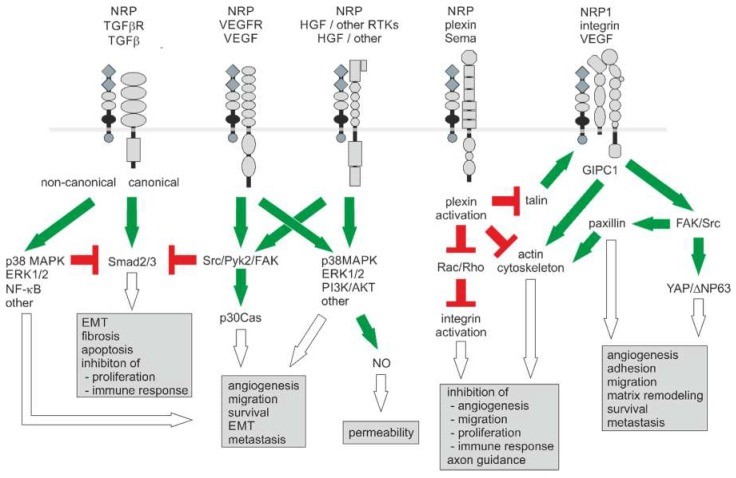
Fig1. Neuropilin-1-triggered signaling pathways in the tumor vasculature and the tumor microenvironment. (Stephan Niland, 2019)
NRP1 Related Diseases
The NRP1 protein has been implicated in a variety of diseases, mainly including neurological diseases, cardiovascular diseases, and tumors. In the nervous system, abnormal expression of NRP1 may lead to neurodevelopmental disorders and neurodegenerative diseases. In the cardiovascular system, NRP1 is involved in the regulation of angiogenesis and vascular stability, and its abnormality may lead to cardiovascular diseases such as atherosclerosis. In addition, NRP1 is highly expressed in a variety of tumors and affects tumor growth, invasion and metastasis by promoting tumor angiogenesis and cell migration.
Bioapplications of NRP1
Because NRP1 is highly expressed in a variety of tumors and is closely related to tumor growth, invasion and metastasis, it has become an important target for anti-tumor drug development. Currently, a number of antibodies and inhibitors targeting NRP1 have entered clinical trials to evaluate their efficacy and safety in cancer treatment.
High Purity
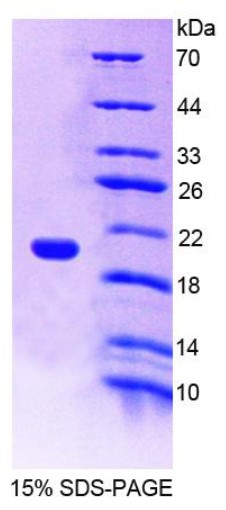
Fig1. SDS-PAGE (NRP1-803H) (PROTOCOL for western blot)
High Bioactivity
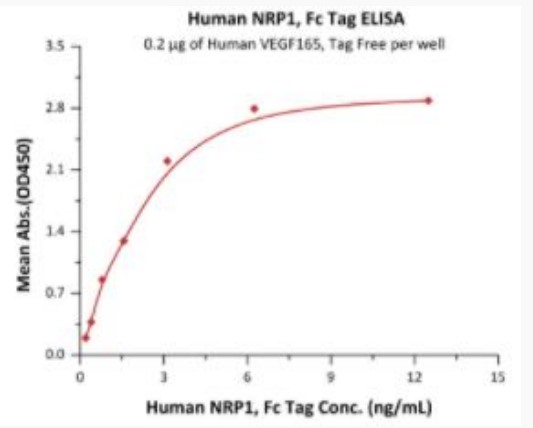
Fig2. Activity Data. (NRP1-3346H)
Case study 1: Liang Jin, 2024
Neuropilin-1 (NRP1), a transmembrane glycoprotein, plays an important role in the malignant progression of gliomas; however, its role in chemoresistance is not fully understood. In this study, the researchers observed the effects of NRP1 on the stemness and chemoresistance of glioma cells and the mediating role of Yes-associated protein (YAP). They constructed NRP1 overexpressing LN-229 glioma cells. Cells were treated with recombinant NRP1 protein (rNRP1) and the YAP inhibitor Super-TDU when necessary. MTT assay was used to detect the sensitivity of cells to temozolomide (TMZ). Western blotting was performed to detect cellular CD133, CD44, p-LATS1, and p-YAP protein expression. Immunofluorescence and flow cytometry were used to detect the subcellular localization of YAP and apoptosis, respectively.
The results showed that NRP1 overexpression and rNRP1 treatment enhanced self-renewal, TMZ resistance, and CD133 and CD44 protein expression in LN-229 cells. NRP1 overexpression and rNRP1 treatment also induced LATS1 and YAP dephosphorylation and YAP nuclear translocation. Super-TDU inhibits NRP1 overexpression-induced enhanced self-renewal and TMZ resistance in LN-229 cells.
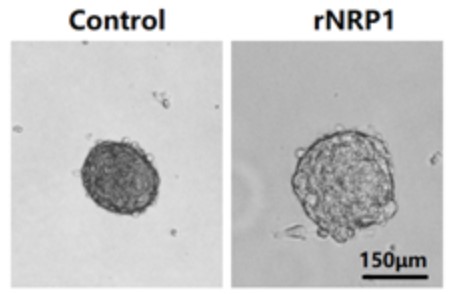
Fig1. LN-229 cells were transfected with rNRP1 treatment for 24 h, and the number and diameter of cell spheres were measured after 7 d of incubation using stem cell sphere culture medium.
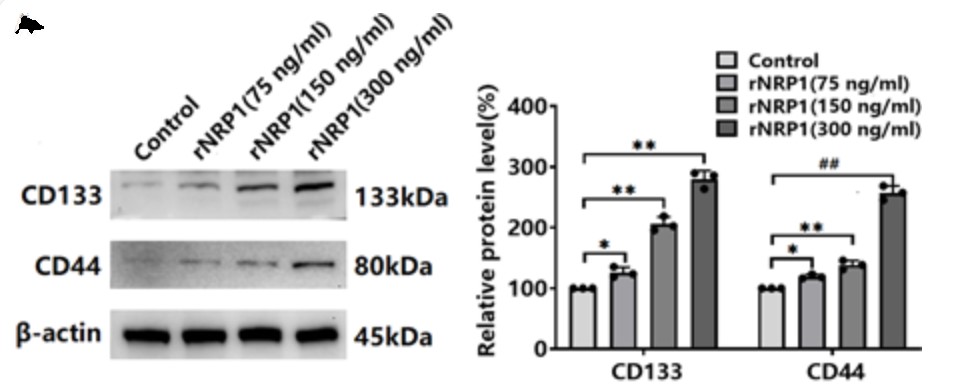
Case study 2: Peng Zhang, 2023
Prostate cancer (PCa) is the most common malignant tumor with a high global incidence in males. The mechanism underlying PCa progression is still not clear. This study observed that NRP1 was highly expressed in PCa and associated with poor prognosis in PCa patients. Functionally, NRP1 depletion attenuated the proliferation and migration ability of PCa cells in vitro and in vivo, while NRP1 overexpression promoted PCa cell proliferation and migration. Moreover, it was observed that NRP1 depletion induced G1 phase arrest in PCa cells. Mechanistically, HIF1α is bound to the specific promoter region of NRP1, thereby regulating its transcriptional activation. Subsequently, NRP1 interacted with EGFR, leading to EGFR phosphorylation. This study also provided evidence that the b1/b2 domain of NRP1 was responsible for the interaction with the extracellular domain of EGFR. Moreover, EGFR mediated NRP1-induced activation of the AKT signaling pathway, which promoted the malignant progression of PCa. In addition, the administration of NRP1 inhibitor EG01377 significantly inactivated the EGFR/AKT signaling axis, thereby suppressing PCa progression.
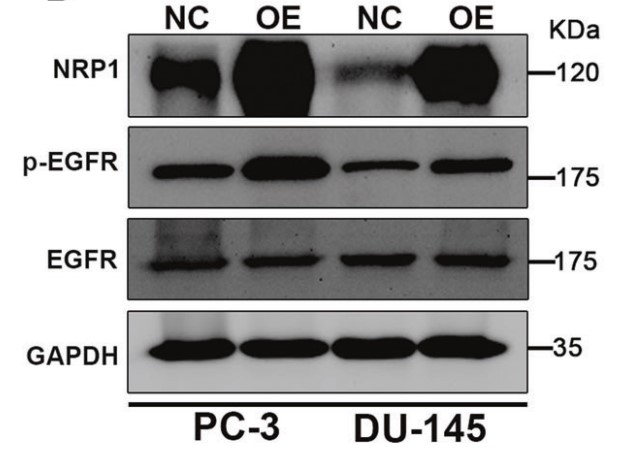
Fig3. Immunoblot assay elucidates that ectopic overexpression of NRP1 promotes EGFR phosphorylation level.
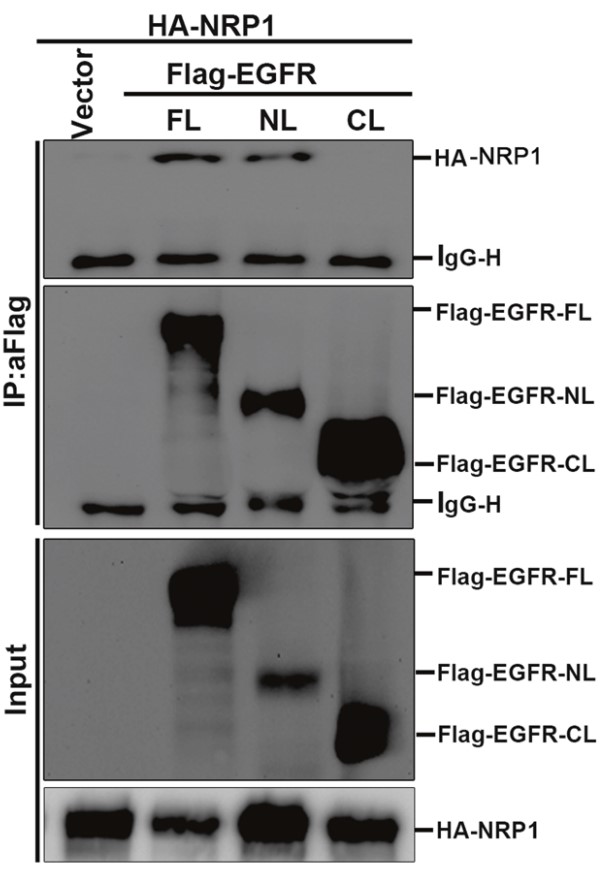
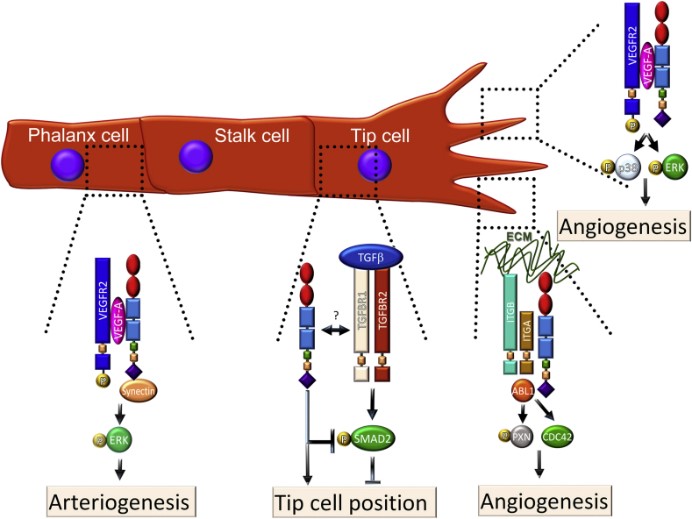
Fig1. NRP1 regulates multiple signalling pathways in endothelial cells. (Claudio Raimondi, 2016)
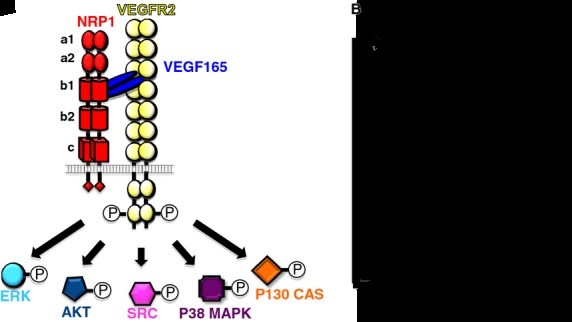
Fig2. VEGF165 induces complex formation between NRP1 and VEGFR2 to enhance VEGFR2 signaling in endothelial cells in vitro. (Alice Plein, 2014)
NRP1 involved in several pathways and played different roles in them. We selected most pathways NRP1 participated on our site, such as Axon guidance, HTLV-I infection, which may be useful for your reference. Also, other proteins which involved in the same pathway with NRP1 were listed below. Creative BioMart supplied nearly all the proteins listed, you can search them on our site.
| Pathway Name | Pathway Related Protein |
|---|---|
| Axon guidance | ANK2B;PPP3R2;TRPC4;EPHB3;SEMA5A;KIF4A;PLXND1;EPHB6;LRRC4C |
| HTLV-I infection | TP53INP1;TERT;CREM;PDGFB;ANAPC5;IL1R1;PPP3R2;ATF4;MSX2 |
NRP1 has several biochemical functions, for example, coreceptor activity, cytokine binding, growth factor binding. Some of the functions are cooperated with other proteins, some of the functions could acted by NRP1 itself. We selected most functions NRP1 had, and list some proteins which have the same functions with NRP1. You can find most of the proteins on our site.
| Function | Related Protein |
|---|---|
| coreceptor activity | CD8A;RAMP3;CCR5;TGFBR3;CXCR7B;NRP1;RGMB;ACVR2A;TMIGD2 |
| cytokine binding | NRP1;KIT;CHRD;IL17F;TNFRSF11A;NRP2;IL31RA;CD74;CNTFR |
| growth factor binding | GHRHR;RHBDF1;ACVR2A;TEK;IL6ST;LTBP4;NKD2;KDR;NRP1 |
| heparin binding | RPL29;CCL8;KAL1;PF4;FGF1;PTCH1;FGF4;FGFR4;SERPINC1 |
| metal ion binding | MCM10;POLM;ZBTB11;ZFP2;CHSY3;ZC3H15;ATMIN;ZNF326;MT4 |
| protein binding | SNRPD2;CSNK1A1;FPR1;ZNF227;PPP1R1A;GNB1;MLLT3;COMP;CD163 |
| semaphorin receptor activity | PLXNC1;Plxna2;NRP1B;NRP1;PLXNB2;PLXNB2B;PLXNB2A;NRP2A;NRP2B |
| vascular endothelial growth factor binding | NRP1;KDR;PDGFRA;PDGFRB |
| vascular endothelial growth factor-activated receptor activity | KDR;NRP2B;NRP1B;FLT3;FLT1;FLT4;NRP2;PDGFRA;NRP2A |
NRP1 has direct interactions with proteins and molecules. Those interactions were detected by several methods such as yeast two hybrid, co-IP, pull-down and so on. We selected proteins and molecules interacted with NRP1 here. Most of them are supplied by our site. Hope this information will be useful for your research of NRP1.
VEGFA; KDR; FLNA; FLT1; RPL27; ptsN1; CSNK2A2
- Q&As
- Reviews
Q&As (6)
Ask a questionIt may be involved in the processes of angiography, inflammation, fibrosis and other processes in the lungs, and is related to the occurrence and development of lung diseases.
The high expression of NRP1 may be related to factors such as the aggressiveness of the tumor and the increased angiogenesis of the tumor.
Yes, NRP1, as a molecule with important biological functions and clinical significance, can be targeted as a target therapy.
This protein can be used as a potential marker in clinical diagnosis for tumor diagnosis and prognosis evaluation.
Yes, NRP1 may be related to the metabolism of drugs, the response to drug treatment, etc., which affects the efficacy and side effects of drugs.
NRP1 may be involved in the regulation of autoimmune responses, inflammatory responses, etc., and is related to the occurrence and development of immune diseases.
Customer Reviews (3)
Write a reviewThe protein has a moderate molecular weight and is convenient to use.
NRP1 can be easily used and measured in experiment.
NRP1 has a high purity.
Ask a Question for All NRP1 Products
Required fields are marked with *
My Review for All NRP1 Products
Required fields are marked with *


